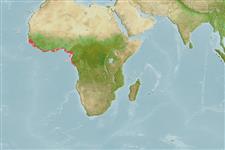Classificação / Names
Common names from other countries
Referência principal
Tamanho / Peso / Idade
Max length : 47.0 cm TL macho/indeterminado; (Ref. 5752); common length : 30.0 cm TL macho/indeterminado; (Ref. 3593)
Length at first maturity
Lm 19.1 range ? - ? cm
Ambiente
; marinhas; estuarina demersal; intervalo de profundidade 0 - 100 m (Ref. 3593), usually 50 - 100 m (Ref. 26999)
Clima / Intervalo
Tropical, preferred 26°C (Ref. 107945); 17°N - 6°S, 17°W - 14°E (Ref. 54743)
Distribuição
Descrição breve
Espinhos dorsais (total): 11; Raios dorsais moles (total): 29-34; Espinhos anais 2; Raios anais moles: 6. Diagnosis: medium-sized fish, fusiform and compressed; head short; eyes rather large; snout short; mouth large and oblique, subterminal; teeth villiform, set in narrow bands in both jaws; 5 marginal pores on snout and 6 mental pores; gill rakers long and slender, longer than gill filaments at angle of first gill arch; dorsal fin long, deeply notched; 2nd anal fin spine very strong, about as long as 1st soft ray and comprised less than twice in head length; caudal fin more or less pointed; scales ctenoid on body, cycloid on breast and head; lateral line extending to hind margin of caudal fin; swim bladder carrot-shaped, its front end with a pair of appendages subdividing into a group of short anterior branches and a bundle of 5-6 slender tubes extending backwards over half the length of swim bladder (Ref. 57396).
Coloration: back olivaceous brown, sides silvery with series of dark dots, belly light, yellowish during reproduction period; spinous part of dorsal fin dark, soft part lighter, with 2-3 longitudinal series of dark dots; pelvics and anal fin yellowish (Ref. 57396).
Categoria na Lista Vermelha da IUCN (Ref. 115185)
Ameaça para o homem
Harmless
Utilização humana
Pescarias: espécies comerciais; peixe desportivo: sim
Mais informação
ReferênciasAquaculturaPerfil para aquaculturaEstirpesGenéticaFrequência dos alelosHereditariedadeDoençasProcessamentoMass conversion
ColaboradoresFotografiasStamps, CoinsSonsCiguateraVelocidadeTipo de nataçãoÁrea branquialOutras referênciasCérebrosVisão
Ferramentas
Relatórios especiais
Descarregue XML
Fontes da internet
Estimates of some properties based on models
Phylogenetic diversity index
PD50 = 0.5156 many relatives (e.g. carps) 0.5 - 2.0 few relatives (e.g. lungfishes)
Nível Trófico
4.1 ±0.70 se; Based on food items.
Resiliência
Médio, tempo mínimo de duplicação da população 1,4 - 4,4 anos (K=0.27-0.4;)
Vulnerabilidade
Low to moderate vulnerability (31 of 100)
Categoria de preço
